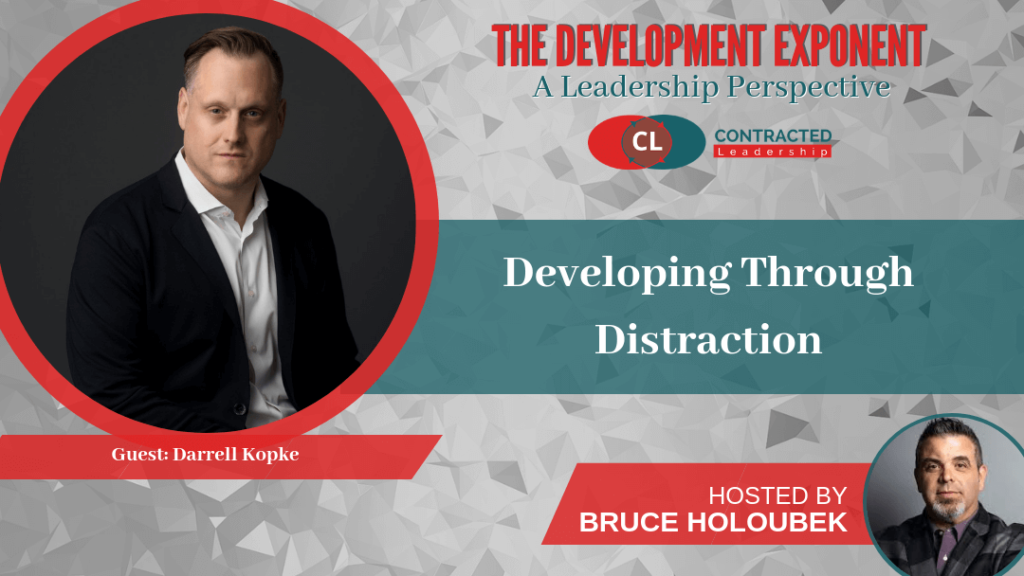
Would you trust someone who doesn’t know how to use a steering wheel drive your car? It’s what we as executives and organizational leaders do when we promote workers to leadership roles who have no sense of personal purpose nor vision for a meaningful mission.
The fault is not in bad hiring, but in a shifting culture that allows less and less time for quiet self reflection and development of an inner guidance system. Take heed that, it’s not you– and you do have the power to make it better.
To help us gain footing on what’s happening and what we can do, Bruce Holoubek, owner of Contracted Leadership, and Host of The Development Exponent Podcast talks with the right expert for the matter– Darrell Kopke.
When bottlenecks develop, disagreements arise, or creativity seems to dry up, bring it back to the purpose question: “Why are we, as an organization doing what we do?” “What is our greater mission?” Click To TweetDarrell is a four-time CEO of high growth organizations, the Founder and CEO of Adelhard Sport Culture Inc. and an adjunct professor of the highly lauded Sauder School of Business at the University of British Columbia. At the university Darrell lectures on entrepreneurship and innovation. What really appealed to Bruce about Darrell, is that he is a “people first” CEO. After reading his article, “Trying Softer” Bruce knew he would do anything to have Darrell on his show.
“Trying Softer” was an article that came out of Darrell’s observation of a growing and disturbing trend he began to see at the university. His students were becoming increasingly distracted, and not present with what is going on in their daily lives.
Would you trust someone who doesn’t know how to use a steering wheel drive your car? It’s what we as executives and organizational leaders do when we promote workers to leadership roles who have no sense of personal purpose nor vision for a… Click To TweetWalking through campus on a picturesque fall morning, Darrell stopped to inhale and revel in the beauty. Looking around to see if anyone else was appreciating the same, he saw heads slanted down into their phones, earbuds plugging the sounds of the birds. Like being the last person left on earth, there was no one to connect with to share the uplifting experience. The opportunity to bask in the inspiration of the day and to inwardly reflect was missing on the students.
Reflect on yourself as a listener. What kind of listener are you? Do you listen with the phone out, or are you focused and present? #levelupyourleadership #leadership #contractleaders Click To TweetSimilarly, when it was time to discuss talents, passions, careers and goals, these students were out of touch. At a time when they need to make massive decisions in their lives about their schooling and career paths, they had no grasp on their goals, talents, or what they wanted to accomplish. The distraction of pervasive attention-thirsty technology was showing its toll.
As leaders and executives who are hiring and mentoring these individuals, we are on stage, we are seen, and we have the opportunity to lead by example. “Trying Softer” is a reminder that we too can step away from our distractions and connect with those around us, especially those who we want to develop as future leaders.
Have you answered the question, “What’s in it for me?” for your whole team? (They are asking it for themselves.) #levelupyourleadership #leadership #contractleaders Click To TweetFirst, leadership development requires us to know our core self. As mentors and organizational leaders we can ignite the spark of that journey in our younger workers by always referring back to the “why.” Why, as a person, are you doing what you do?”
Secondly, leadership development requires for us to connect our personal why to the why of the organization. When bottlenecks develop, disagreements arise, or creativity seems to dry up, bring it back to the purpose question: “Why are we, as an organization doing what we do?” “What is our greater mission?”
Keeping the encompassing purpose at hand really changes the outlook on what we are doing. It can make even the most mundane task more meaningful. Take the bricklayer story as example:
A man sees three bricklayers and asked the first one, “What are you doing?”
The first bricklayer says, “I am laying bricks, obviously!”
The second bricklayer says, “I am building a wall.”
The third bricklayer says, “I am building a cathedral!”
As organizational leaders we can provide context to our workers, showing that who we are being is legacy based. Who we are being is a contribution that is bigger than ourselves, and what we are doing is not just completing a task like bookkeeping or editing, or calculating, but that we are activating a vision.
Question: How does your business make the world better? We’d love to see your answers! #levelupyourleadership #leadership #contractleaders Click To TweetThis shifts the lens of how we view ourselves and how we view our businesses. It helps us refine the question of what we are really doing. Are we selling children’s clothing, or are we promoting outdoor free-play culture?
How does the world benefit from your business? We’d love to hear from you! Comment or email your reply.

